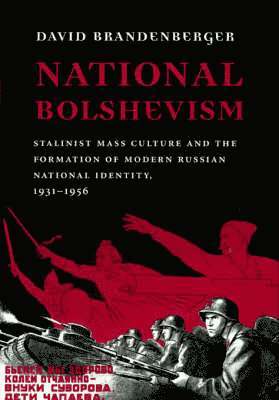
- Format
- Inbunden (Hardback)
- Språk
- Engelska
- Antal sidor
- 400
- Utgivningsdatum
- 2002-12-01
- Förlag
- Harvard University Press
- Illustrationer
- 10 halftones, 1 table
- Dimensioner
- 24 x 168 x 243 mm
- Vikt
- Antal komponenter
- 1
- ISBN
- 9780674009066
- 728 g
National Bolshevism
Stalinist Mass Culture and the Formation of Modern Russian National Identity 1931-1956
Slutsåld
Kundrecensioner
Fler böcker av David Brandenberger
-
Epic Revisionism
Kevin M F Platt, David Brandenberger, Kevin M F Platt, Kevin M F Platt
-
Spanish Peru, 1532-60
University Of Wisconsin Press, James Lockhart, David Brandenberger
-
Propaganda State in Crisis
David Brandenberger
-
Stalin's Usable Past
David Brandenberger
Recensioner i media
Brandenberger alters our understanding of how Soviet culture was created and how it held Soviet society together. Perhaps the greatest strength of the book is the foundation of documents on which it rests. Clearly the result of years of gathering, these documents show us Stalinism as received, as a set of social practices and discourses in constant revision and misuse. "National Bolshevism" illuminates broader debates about the functioning of Soviet society, the origins of national consciousness, and the formation of the subject with the modern state, and will be a widely read contribution to the field.--James von Geldern, Macalester College
Övrig information
David Brandenberger is Assistant Professor of History at the University of Richmond.
Innehållsförteckning
List of Figures and Table A Note on Conventions Terms and Acronyms Introduction: Mobilization, Populism, and the Formation of Modern Russian National Identity 1. Tsarist and Early Soviet Society's Weak Sense of National Identity Part One: 1931-1941 2. Mobilizing Stalinist Society in the Early to Mid-1930s 3. The Emergence of Russocentric Etatism 4. Ideology in the Prewar Classroom 5. Popularizing State Ideology through Mass Culture 6. The Popular Reception of National Bolshevism on the Eve of War Part Two: 1941-1945 7. Wartime Stalinist Ideology and Its Discontents 8. Ideological Education on the Home Front 9. Wartime Mass Culture and Propaganda 10. Popular Engagement with the Official Line during the War Part Three: 1945-1953 11. Soviet Ideology during the Zhdanovshchina and High Stalinism 12. Public and Party Education during the Early Postwar Period 13. Postwar Soviet Mass Culture 14. The Popular Reception of Ideology during Stalin's Last Decade Conclusion: National Bolshevism and a Modern Russian National Identity Appendix: Civic History Textbook Development, 1934-1955 Notes Index
Du kanske gillar
-
Peak Human
Johan Norberg
Häftad -
Peak Human
Johan Norberg
Inbunden
